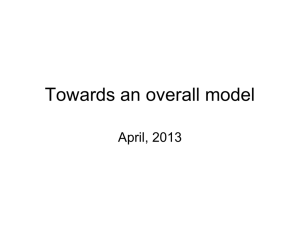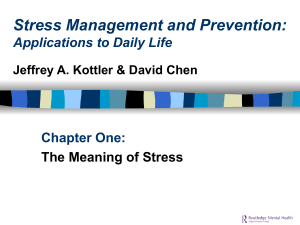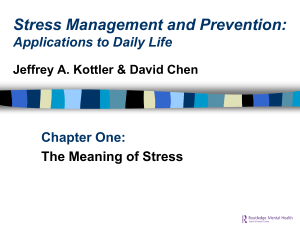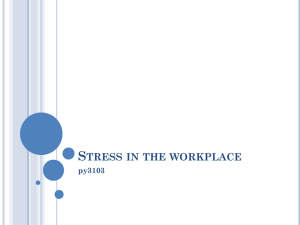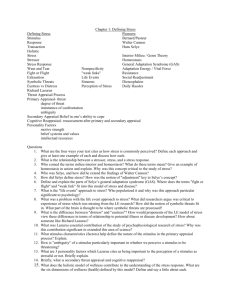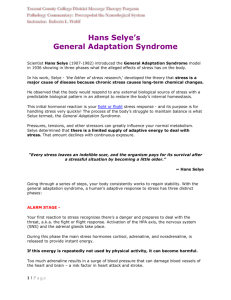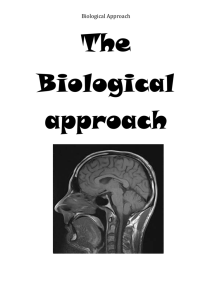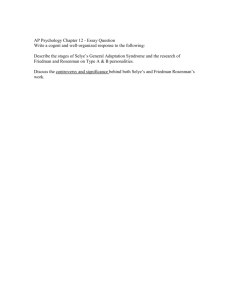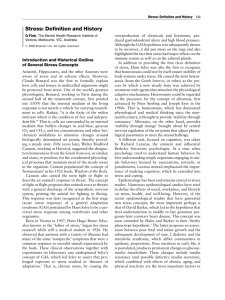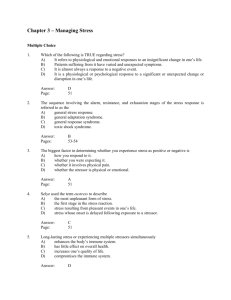Hans Selye - Klicks-IBPsychology-Wiki
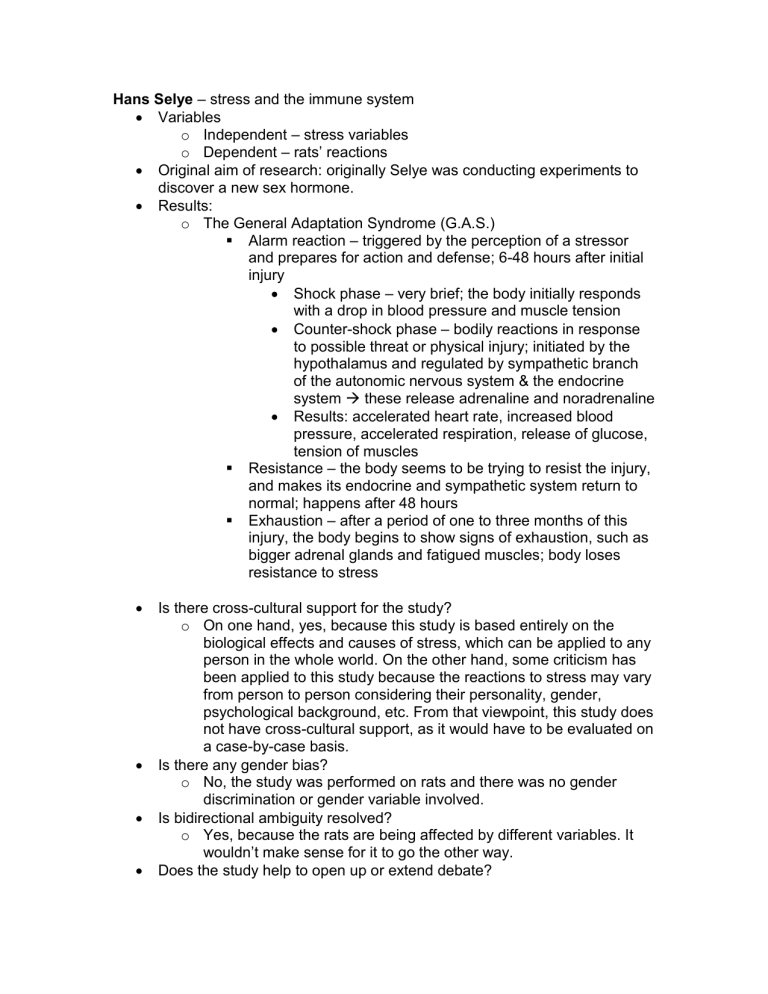
Hans Selye
– stress and the immune system
Variables o Independent – stress variables o Dependent – rats’ reactions
Original aim of research: originally Selye was conducting experiments to discover a new sex hormone.
Results: o The General Adaptation Syndrome (G.A.S.)
Alarm reaction
– triggered by the perception of a stressor and prepares for action and defense; 6-48 hours after initial injury
Shock phase – very brief; the body initially responds with a drop in blood pressure and muscle tension
Counter-shock phase – bodily reactions in response to possible threat or physical injury; initiated by the hypothalamus and regulated by sympathetic branch of the autonomic nervous system & the endocrine system
these release adrenaline and noradrenaline
Results: accelerated heart rate, increased blood pressure, accelerated respiration, release of glucose, tension of muscles
Resistance
– the body seems to be trying to resist the injury, and makes its endocrine and sympathetic system return to normal; happens after 48 hours
Exhaustion
– after a period of one to three months of this injury, the body begins to show signs of exhaustion, such as bigger adrenal glands and fatigued muscles; body loses resistance to stress
Is there cross-cultural support for the study? o On one hand, yes, because this study is based entirely on the biological effects and causes of stress, which can be applied to any person in the whole world. On the other hand, some criticism has been applied to this study because the reactions to stress may vary from person to person considering their personality, gender, psychological background, etc. From that viewpoint, this study does not have cross-cultural support, as it would have to be evaluated on a case-by-case basis.
Is there any gender bias? o No, the study was performed on rats and there was no gender discrimination or gender variable involved.
Is bidirectional ambiguity resolved? o Yes, because the rats are being affected by different variables. It wouldn’t make sense for it to go the other way.
Does the study help to open up or extend debate?
o It doesn’t resolve or support any debate because there was none to begin with. Instead, it opened up research on the effects of stress and hormones on brain function. This study is said to be the cornerstone of neuropsychiatry.
Has it defined or helped to clarify the meaning of any concepts in psychology? o It has introduced the concept of the General Adaptation Syndrome, and given a clear definition of the meaning. It has also defined better what stress is, including what effects it can have on your body.
Does the study employ concepts and definitions that can be criticized? o The General Adaption Syndrome, being both a new concept and an important discovery, can definitely be criticized. For example, the study ignores psychological factors that can effect the reactions to stress, as well as ignores personality and gender. Also, the research was done on animals, which could have problems of accuracy.
Does it reflect the values of a perspective or the psychologist? o The study was done according to the biological perspective, using quantitative experiments. It assumes that there is a biological behavior to the reactions these rats have to the stress variables.
Also, it assumes Darwinism, that bodies will be adaptable and will resist stress.
Are there other possible explanations that the study overlooks? o The study does not take into account anything relating to the psychological emotions and variables at the time of the study. It focuses entirely on the biological aspect. It also does not take into account personality or gender.
What are the advantages/disadvantages of the methods used in the study? o Advantages:
The study has quantifiable data, based entirely on experiments and results o Disadvantages:
The study is reductionist – there are other factors that could be possible explanations that need to be explored
The study used animals, who have different DNA structures than humans do, and their reactions might be different.
Is the sample representative? o It is not because reactions to stress might vary for each person.
Is the study reliable? o The study is reliable because Selye has published many books on it and his further studies. His data is quantified and the experiments are reproducible.
Is the study supported by other research?
o The study was new in its kind so there had not been any research before it, but it has been supported by further research by other psychologists.
Is the study ethical? o The study is not entirely ethical because Selye used stress variables that could have been harmful to the rats, such as starving them, giving them an excessive amount of drugs, and made them exercise until complete exhaustion.
Is the study ecologically valid? o Yes, this study is ecologically valid.
Is mundane reality achieved? (is the situation realistic/believable?) o Not in its entirety because the mice were treated as if they were all the same, when it should have been taken into account that they each had different backgrounds.
Are there any procedural issues that would make replication difficult? o It might be unethical to do nowadays, with the new rules on experiments.
Could there be observer bias? o Yes, because while carrying out the experiment, Selye was looking for only biological signals, not psychological ones, so some observations might have been excluded or ignored.
Could demand effects have affected the outcome? o No, because Selye was looking at the outcomes through only the biological perspective, and it did not change throughout the study.
Is construct validity established? o Yes, construct validity is established in the study.
Is there inter-rater reliability? o Yes, because there has been much support for this study, and it has been the stepping stone for many other studies.
How much training was necessary? Could maturation have taken place? o Not much training was necessary because Selye
Could the study be contaminated? o No, because Selye used only one stress variable at a time.
Is this a correlation, or can causation be determined? o Causation can be determined, because the rat’s reactions are direct effects (even though the ones Selye listed are only the biological ones) of the stress.
Sources: http://www.woodlands.derby.sch.uk/departments/humanities/psychology/psychol ogy%20site/physiology-of-stress-introduction-hans-selye.html
http://neuro.psychiatryonline.org/cgi/content/short/10/2/230a
